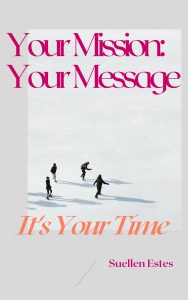
by Suellen | Marketing Success, Write Your Own Book
Few things demonstrate your expertise on a subject as much as a book. That’s why so many coaches, speakers, marketers and others choose to publish books in their niche.
So what does a book do?
It gives you:
- Instant credibility—after all, you know enough to fill a book!
- An unforgettable business card—take a few with you to your next live event.
- Opportunities to reach a new market—many people will find you first through your book, not your blog.
- Speaking opportunities—event planners frequently seek out authors to speak at conferences and other gatherings.
- Bigger paychecks—all that credibility means you can—and should—be charging more.
But your book isn’t the only tool in your author arsenal. If you publish on Amazon, whether as a Kindle author, KDP Paperback author, or with a traditional publishing house, you are entitled to an “Author Page.”
Just like the about page on your website, this is where Amazon browsers go when they want to know more about you. Say for example they’re browsing for information about business branding, and they find your new book. If you’re an unknown to them, it’s hard to know if you have the information they’re looking for. That’s where your author page comes in.
By clicking through to your page, new visitors can learn about:
- Your experience and expertise
- Other books you’ve written
- Your blog and the topics you cover there
- Upcoming events
They can even ask you a question or two. What better way to decide if that book is worth the investment in time and money than to get to know the author better?
But many authors simply don’t take the time to make the most out of their author page, and they’re missing out—not only on an opportunity to make a great impression, but on the chance to earn more money as well.
Sign up below for a Free PDF with Tips for a Successful Amazon Author Page.

by Suellen | Write Your Own Book
I am thinking back to a special August day in 2010. My husband and I had just celebrated the birth of a beautiful grandson, so I was already on an emotional high. And then as we arrived back home and saw the box on our porch, I could hardly contain the excitement.
My books had arrived! My very own books!
With trembling hands, I opened the box and saw my name staring back at me. My beautiful books. All the work I had put into this masterpiece (at least to me, it was a masterpiece) – had paid off.
It was done. My very own book ready to give and to sell. Ready to bring encouragement to those who read it. Ready to open new doors for me since now I was a published author.
I began to reflect. I had wanted to write this book for a long time – mulling over ideas for many years. Why had I waited so long to actually do it?
Many things had held me back from experiencing this moment.
There had been confusion. And overwhelm. How could I write a whole book? What if I didn’t have enough to say? Who would really want to read it? Would it cost too much? And on and on…
Obstacles of thought and emotions. Fear, anxiety, and overwhelm.
I just wasn’t sure that I could do it.
Do you relate to what I’m saying? Do you have obstacles of mind and emotions which hinder you from accomplishing what you want?
Let’s face it. Each of us has obstacles in our life’s journey.
Some of these are because of our environment, our health, or our unique circumstances. We may be dealing with sickness in ourselves or a close family member. We might be going through a major life change – such as a divorce or the death of someone close.
Sometimes demands are made on our time and energy by good seasons in our lives. We may have several small children who need an usual amount of attention. Or we may be getting married or starting an engaging career.
Yet when life is rolling along at a more even pace (if that ever really happens), we can still face obstacles in our minds. Our thoughts, our emotions, and our habits can cause us to stand still and not move forward.
We may occasionally dream about the “what if’s,” but we don’t take any steps toward accomplishing those dreams. We treat our lives as if we will either win the lottery – or not. The big moment will come, or it won’t.
And in the meantime, we remain idle without moving toward those dreams.
Well I have met many people who have a dream of writing a book. Maybe they have a great story concerning their own unique experiences. Perhaps they realize that a book would be just the thing to introduce Jesus to those who don’t know Him. cement their credibility in their field. Maybe they want to make some extra money from the book sales.
There are many reasons for writing a book.
Yet here is the truth: Many talk about it, but very few ever really get it done. They dream and they talk, but they never actually do it.
I understand this dilemma, because that’s the way I was for many years. I would think about it. I would even occasionally jot down a few notes. But I just couldn’t get over that unidentifiable roadblock. It just seemed too hard. Out of reach. I would put it aside and forget about it for awhile.
Well my day finally came, and what made that switch for me?
I began studying about self-publishing. I read books, attended seminars, and online webinars. Somehow, during that process, I gained courage and began the journey. One step at a time, I completed the trip and published my first book.
I realized that those who were writing their books were just like me – like you. If they could do it, then so could I.
Now several years later, I have more than 20 books published in paperback and on Kindle. Once I started the process, each one became easier.
Now my goal is to help others who were just like I was.
Maybe you are one of them.
If you have been thinking about writing your book but haven’t done it yet, then maybe overwhelm or confusion is holding you back.
In my series of 12 On Demand Webinars, Audios, Transcripts, Action Step Sheets, and Bonuses, I take you step by step through the process. Your Planning, Writing, Pre-marketing, Designing, and Publishing can be accomplished by you – just as they were by me. One step at a time – and it’s done.
Please check out the opportunity. At https://OurCBI.com. The world needs to hear from you.
And for a limited time, the entire course will be half price.
In the meantime, Keep on Soaring!

by Suellen | Write Your Own Book
There’s just Not Enough Time!
I have to say, this has been my lament in many situations.
Of course, we know the adage that “everyone has the same 24 hours.” But that adage didn’t make any difference when I was attempting to get more done.
With a church to oversee. Children and grandchildren. Serving on City Council. Other community activities. And on and on.
Then I read Stephen Covey’s book again. 7 Habits of Highly Effective People.
Do you remember the chapter about the rocks in a jar?
First, you have a pile of rocks of many different sizes and you fill the jar the best way you can. Many rocks get left out. They just won’t fit. There’s not enough room.
Then you try a different approach.
You put in the big rocks first. Then the middle sized ones. Finally you can fill in the crevices with the tiny rocks and pebbles.
Covey was linking this demonstration with time management. There are those big things, which require most of our time. The nine-to-five job. The running of the house. Childcare. Church work. Daily devotions.
Next come the middle sized time demands. Personal care. Doctor and dentist appointments. Volunteering at your child’s school carnival.
Then there are those little items. Leave dog at vet. Drop off cleaning. Write a quick note to teacher. You know those tiny time consumers which can overwhelm your day if you let them.
So Covey recommends that you take out your calendar and insert the large items first. Then the middle-sized. After those bigger plans are marked out on your calendar, it will be surprising how much vacant space you will see.
This Covey suggestion is what I like to use.
All those tiny time consumers can be put on a list. You have 10 minutes while you are waiting for your child? Pull out an item from your list and whip it off quickly. A phone call. A note. Paying a bill. Making a grocery list or planning a meal.
It’s amazing what can be done with proper planning.
But this is the best part: When you plan your time in this way, there will still be some blank spots on your calendar.
Those are the times you can use to take on some long term projects. Those things you don’t think you have time for right now.
That, in fact is how I wrote and published my first book.
After years of feeling inadequate and too busy to write, I marked my calendar and found some time. Maybe an hour here. Two hours there.
It’s amazing what concentration and commitment will do for us.
Those smaller moments add up, and soon the project is completed. That “wow” moment when it’s done!
The excitement of completing that first book was worth all of the effort I had put into finding the time. All of the organization and planning. That first book was worth whatever-it-took to do it! I was a published author!
Now I have to say that there are other ways of establishing time for a project. That’s why I devoted a whole webinar in my course “It’s Time For You To Write That Book, 2.0” to The Time Factor. I discuss the Big rock/little rock method. I also discuss some other approaches.
Everyone is different. Even though this Covey idea suits me, not everyone thinks or works in that fashion.
But there are other ways of getting the job done. Other plans for finding or making the time for long term projects you want to do.
Plans which will help you to write your book. To make that lasting impact you want to make.
Be blessed. And remember to Keep on Soaring!

by Suellen | Write Your Own Book, Writing Tips
Do You Have Enough to Say for a Book?
When working with writers, I hear about all sorts of obstacles. Not enough confidence. Not enough time.
One of the biggest is “Not enough to say.”
Sometimes people will begin to write a book and spill everything they can think of onto a page, only to find that all of their thoughts amount to just a short amount of writing.
Then discouragement sets in and the familiar lament, “I don’t have enough to say to write a book.”
This is a common problem, and one which most writers face.
Often the issue is that famous “writer’s block.” There are tons of techniques for getting over this hump.
On other occasions, the writer truly doesn’t know enough to say. The standstill is real.
That’s why one of my webinars in It’s Time For You To Write That Book 2.0 is dedicated to research and information.
When you are writing your book, you don’t have to be the origin of every idea you include. As long as you give credit, your book actually has more significance when you include quotes and thoughts from other writers. That’s actually a plus and not a minus.
And also there is that wonderful world of Private Label Rights and Public Domain. These are books, articles, photos, and other items which you are free to use as if they were your very own.
The rights differ from item to item, but often you can – and even are encouraged to- change them. You can add your voice and put these pieces into the context of your book. There are e-books available which can be edited and included in your portfolio.
I love talking about this, because it’s truly a treasure trove for authors. Even if you are the top authority in your field, your expertise is enhanced by the expertise of others.
So if you have thought that you didn’t know enough to write your book, you’ll get some good ideas from my On Demand Course. For a short time, the entire course with videos, audios, transcripts, and lots of bonuses can be obtained at https://OurCBI.com. At almost half price.
I hope you check it out. Your book is important for establishing your credibility, and others will be inspired and encouraged by what you have to say!
We’ll talk soon.
In the meantime, Keep on Soaring!

by Suellen | Write Your Own Book, Writing Tips
You have these ideas circulating in your head, and you can hardly wait to start writing them down. You know your subject and you know it well. Maybe your area of expertise is Biblical understanding of marriage, or prayer, or finances, or ministry to women in crisis. If you’re already an expert in your niche, then you can probably sit down and write an article, a report, or an e-book without having to consult any sources.
Yet if you’re like most people, then you need to do some research before you start writing. Even if you are an expert, researching other resources can help you to expand the benefit of your writing. And if you want to end with an accurate, useful article, then you’d better be sure you do your research the right way.
So here are some tips…
Create Multiple Searches
You’ll get a wider variety of sources and information if you complete several Google searches. Let’s suppose you’re looking up information about prayer. You’d want to do several searches, such as:
- Praying for family
- Praying for children
- Praying for husband or wife
- Praying for revival
- Biblical prayer
- Christian prayer
- How to pray
These are just a few ideas. You will think of your own, but you will see that as you search, you will come up with quite a few sources of information.
Use Credible Sources
Anyone can put just about anything online. And that’s why it’s so important for you to get your information from credible sources only. This includes:
- Well-known experts. For example, you can trust people like Cindy Jacobs, Dutch Sheets, or Germaine Copeland in the prayer niche.
- Established authority sites. These are sites like Elijah List or John Bevere’s Messenger International.org which are known for providing high-quality information.
- News sites. Stick to major news sites, like Charisma News or Breaking Christian News.
- Academic and research sites. These include official university websites as well as research papers in peer-reviewed journals. Oral Roberts University or Lee University are just a couple of universities which would have valuable information.
Verify With Multiple Sources
Even if you are going through credible sources for your research, be sure to use multiple sources.
In other words, verify all facts with at least two or three credible sources. In the mouths of two or three witnesses let everything be established. (Deut. 19:15)
Make Notes
As you’re doing your research, take notes about important points. If you think of your own examples, stories or tips, write these down too.
That’s because you’re going to want to close all your sources before you start writing to avoid accidentally plagiarizing anyone else’s material. Thus you’ll refer to your notes rather than referring directly to a source.
Tip: In order to create truly original content, it’s best if you find your own fresh angle for the topic. For example, many writing books and articles refer to the importance of telling stories to illustrate your points and grab attention.
Credit Your Sources
If you’re using multiple sources to do your research on something which is written about often, like prayer, then generally you’ll find that the information is the same across these sources.
Thus you just need to write the information in your own words and add in your own unique tips, examples, and stories.
However, if you’re gathering research on something specific, and quoting someone exactly, then you need to cite your source.
In this case, you’d track down the original scholarly journal and cite this journal at the end of your article, report, or e-book.
In summary…
You need to make sure your information is accurate by researching a variety of credible sources. However, you also need to make sure that any content piece you create is completely original.
So while you can certainly use a content piece for inspiration and research, you cannot copy or merely “rewrite” other people’s work. Instead, you need to write all your content in your own words, preferably adding in your own experiences whenever possible.
The result is fresh information, drawing upon the experience of others, but filtered through your own understanding. That’s how you can inform and inspire your audience.
As you continue with your research, you will find many ideas which you might like to use in your own articles. By drawing upon the experience of others – as well as your own – you bring new inspiration to your audience.
You and your audience will be inspired as you do.

by Suellen | Write Your Own Book, Writing Tips
Can you imagine a house being created without a blueprint? The final product would be a sight to behold. The walls probably would be mismatched, the rooms would be randomly placed, and the final outcome would be a hodgepodge. Any project, whether it is a building, a work of art, or a writing project, needs to have a basic plan. A sort of skeleton onto which the flesh of the project will be placed.
That’s what your outline is for your writing project. When you have a good outline, you have a plan which will go a long way toward guaranteeing your successful outcome. In fact that is one of the keys to creating a great piece of writing. And yet many writers completely overlook this step, particularly when they’re writing short pieces like articles and reports. So where do you start?
Step #1: Pick Your Topic
Spend some time thinking about what you want to say. What is the main point you want to get across? As you do this exercise, remember that you need to focus on your audience you are reaching. You’re already working in a specific niche, so now you just need to pick a topic for your article, report, e-book or other content piece. Obviously, you want to choose a popular topic.
You can do this by:
- Looking at paid products (on sites like Clickbank.com and Amazon.com) to see which topics are being sought by people. When you see a lot of interest in a certain area, you know that people are seeking answers in that area, and you know that you can help them.
- Checking out niche forums and blogs to see which topics generate a lot of interest and discussion. (A concentrated Google search will locate some of these tools).
Step #2: Choose Your Primary Goal for This Piece
Once you’ve picked your topic, then you need to decide what your goal is for this piece. You can also decide the approximate length.
Examples:
- Is it an article for your blog? If so, what is the goal of this article? For example, is it to provide spiritual answers for your audience? Is it to encourage your following to pray for revival? Or is it to get people to join your email list?
- Is it a free report, introducing yourself? If so, then the goal is to “warm up” prospects and get them to click your links. You want to show people who you are, and how you can help them.
- Is it a paid e-book? If so, then the goal is to give your readers in-depth instructions and encourage them to take action.
Knowing your primary goal will help you keep your writing focused on the goal.
Step #3: Do Your Preliminary Research
If you’re not an expert in the niche, then you’ll need to do some initial research in order to determine what steps, tips, or topics you need to cover in your piece. (More about this Here).
Note: A simple keyword search (such as “how to pray successfully”) will uncover hundreds of similar content pieces, so you can look at these pieces to determine which topics you need to include in your article, report or e-book, too. Remember, don’t expect to be the only voice out there solving problems or bringing encouragement.
Tip: If you’re writing a book, go to Amazon.com and search for similar books. That’s because Amazon let’s you take a peek inside the book to see the table of contents. These tables of contents will give you plenty of ideas about what topics to include in your book.
Step #4: Create Your Outline
Once you have a good idea about what topics to include in your content piece, now it’s time to create your outline.
If you need guidance as to how to order your topics, just go back to your research to see how other popular content pieces ordered their topics. Otherwise, here are a few general guidelines:
- Logical order. If you’re describing a step-by-step process, then obviously your outline will list the steps in order.
- Beginner to advanced material. Self-explanatory – put the easier material at the beginning of your piece.
- Faster results to slower results. If you’re listing different tips or strategies, you might order them from those that get quick results to those that take longer to implement.
- Mix of tips. Here you might put one or two of your BEST tips in the beginning and then put another one or two of your best tips at the end.
Next, you should assign an approximate word count to each section, which will help you stay focused on the most important parts of your content piece.
Finally, don’t forget to look at your outline to ensure that it helps you meet the goal of your content piece (such as preselling a product or teaching your readers a process). If your outline looks good, then it’s time to start your writing!










